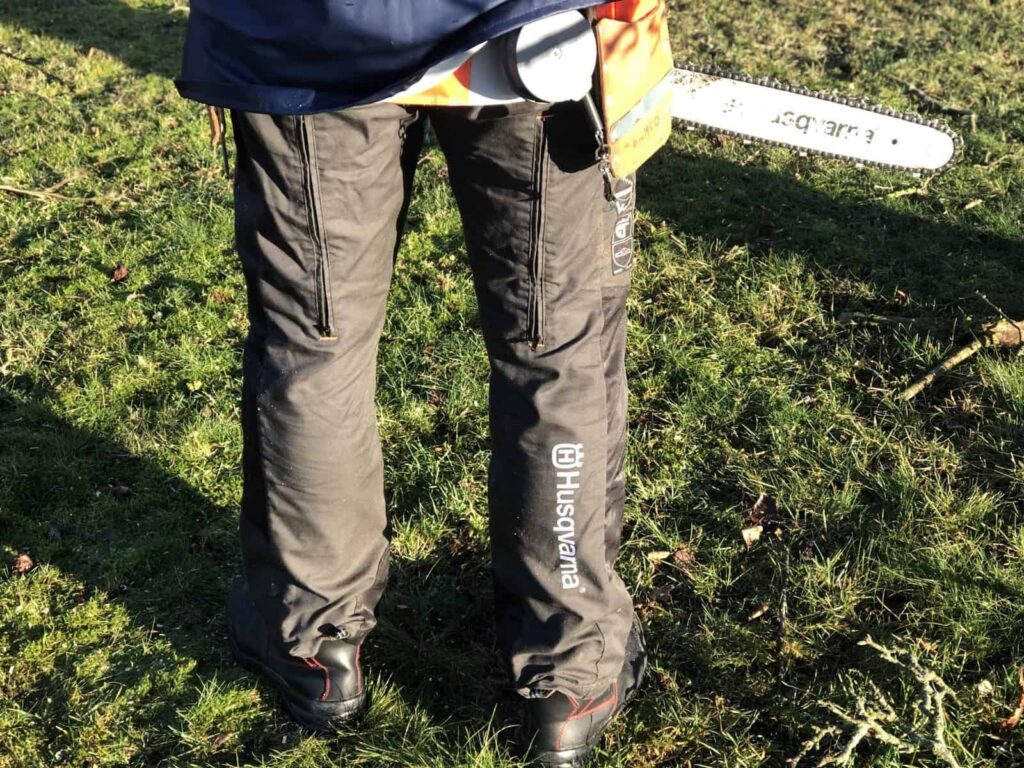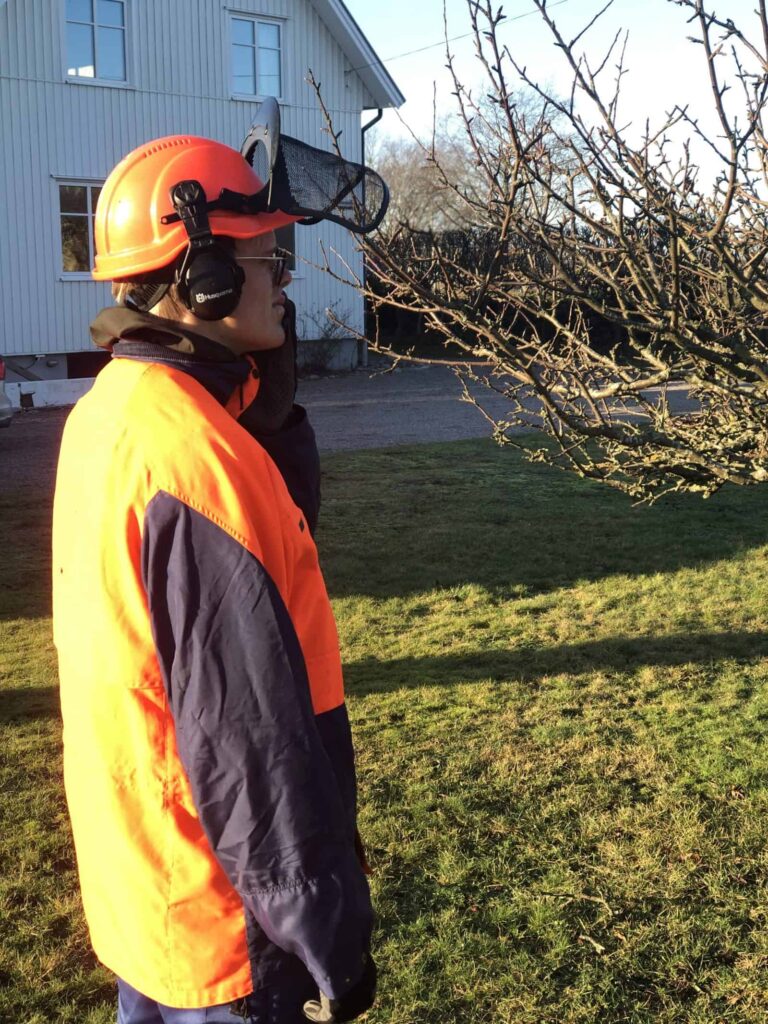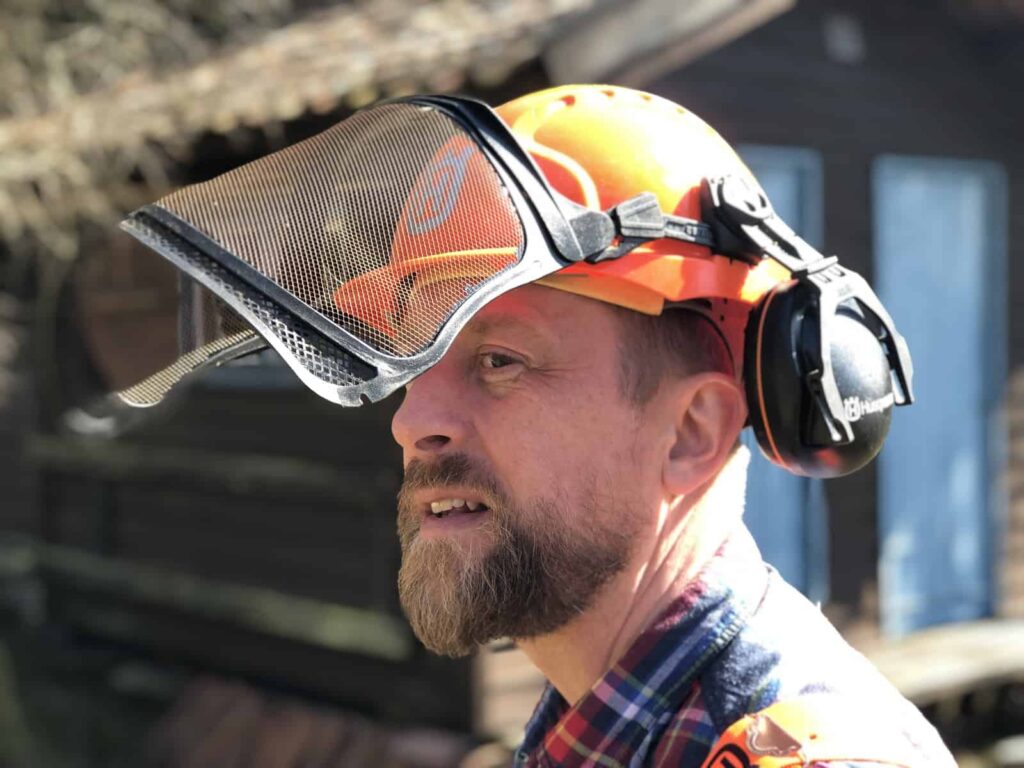A chainsaw is a tool that you must have great respect for and handle with knowledge. If you are careless, sloppy or do not use it correctly, it can maen some large and serious injuries.
One way to avoid really big accidents is to use good personal protective equipment and clothing from head to toe.
It is important that the protective clothing fits well and correctly to provide the greatest protection. If they are damaged, they need to be replaced and replaced with new undamaged items.
Table of Contents
Safety boots or safety shoes
You can find both safety boots and shoes that protect and fit well that are specialized for chainsaw use. Keep in mind that it should be a solid sole that gives a good grip regardless of the surface in the forest.
A steel cap at the front of the shoe is preferable, if a tree or large branch falls over the foot, it will protect from the more serious injuries.
Trying on the boots or shoes before buying is also important, as how they sit over the foot can vary and being comfortable while working is often forgotten.
You also want to consider the material of the shoe, as it needs to hold up to wear and tear. Often times the ground can be wet and muddy and it is important that the shoe stays dry.
Our picks for safety shoes and boots can be found here.

Protective pants and chaps
Prices for protective trousers for chainsaws start from relatively low and then rise upwards. The difference is a lot due to the weight of the trousers, level of protection and how easy they are to move in. I would always recommend getting protective pants even if you only use your chainsaw a few times a year, it is a cheap insurance to protect from very serious injury. However, you may not need the most advanced pants as a hobby users compared to someone how who does forestry work on a daily basis.
There are pants both with and without suspenders which can be a matter of taste. It is always possible to supplement the trousers with detachable suspenders at a later time.

Protective jacket
When working with a chainsaw, it is important to have a protective jacket that is clearly visible. Most models on the market are in bright orange colors and often with reflective elements for better visibility for late hours of the day when it is dark or dusk.
A good jacket should offer good freedom of movement and at the same time transport away sweat and moisture in an efficient way. It is also good if the jacket can withstand wet and can be used in rain.
Protective jackets with extra safety lining are rare as it is mostly the legs and feet that are in risk of injury when using a chainsaw.

Really good safety gloves
Safety gloves are important as they keep your hands warm and help to give a good grip around the handle of the chainsaw. But above all, they are very important as they protect the hands from the chainsaw if you happen to access the chain.
The gloves must be compliant and not prevent fingers and hands from moving, but are barely noticeable when used.
A pair of sturdy garden gloves can work as a good compromise solution, however we would recommend gloves created specifically for chainsaws and blade equipment use.
Protection for eyes, ears and head
While cutting wood chippings will fly and if you get it in the eye, there could be permanent damage. Therefore is imperative that you get some safety goggles or glasses while cutting, this is most likely the cheapest protection you can get and should never be skipped.
Ideally you would want the glasses, a helmet to protect your head from falling debri and hearing protection to protect your ears from the loud engine noises. Many helmets today have both a visor and hearing protection built-in. However, it can vary slightly and be a matter of taste
around what you want, regardless of whether everything is separate or everything is built-in, it is important that they fulfill their function.

Where should i buy personal protective clothing?
There are many manufacturers of protective clothing, but my personals favorites are Oregon and Husqvarna, which is why most examples and reviews come from them. If something breaks, or some need to be replaced, it is often easier to get support from a well-known manufacturer.
When it comes to quality, there are probably many manufacturers who can guarantee both high safety and comfort when it comes to their clothes. However it is very important that you buy your clothes from a reputable and trustworthy seller, which sometimes Amazon sellers are not known for. Your safety is always worth more than saving a few dollars on buying a cheaper item, something you should always consider when buying personal protective equipment.
Try on different clothes
It is important that the clothes fit well as any loose parts can easily get caught on branches or sticks and increase the risk of injury. Because all people have different body types, it is usually best to try on the items in a store or be able to return them if they doesn’t fit as expected. Always buy from a store or from a retailer that has a good return policy, as it is easy to return items if you experience issues later on.
Damaged protective clothing
If the protective clothing starts to be worn or has been damaged in some way, it is incredibly important that they are replaced with new and whole ones. If the chainsaw slips and damages the clothes, it is not possible to guarantee protection in the future.
After each use, it is therefore both good practise and important to go through the equipment and ensure that there is no damage before future use.
As often, it is not possible to compare what equipment and protective gear you need as a hobby enthusiasts compared to a Professional practitioner who work in the area on a daily basis, have completely different requirements for clothing and its functions.
The clothes that will be recommended in this article are therefore mainly be aimed at hobbyists and not people who handle a chainsaw on a daily basis by profession.


